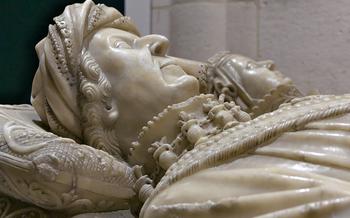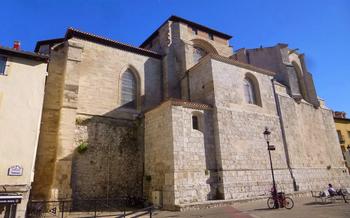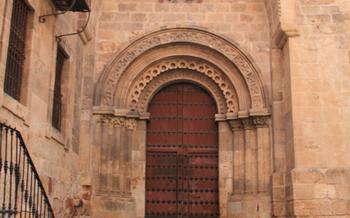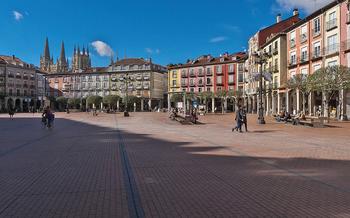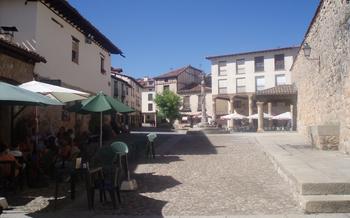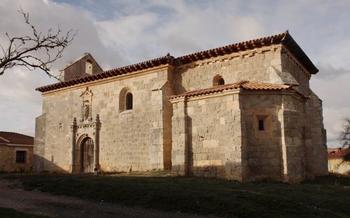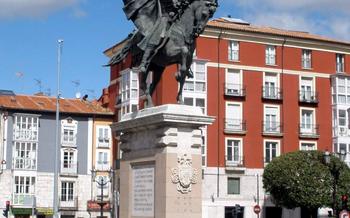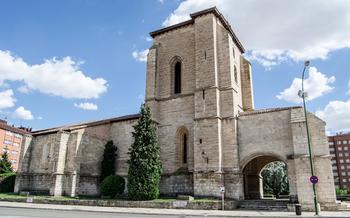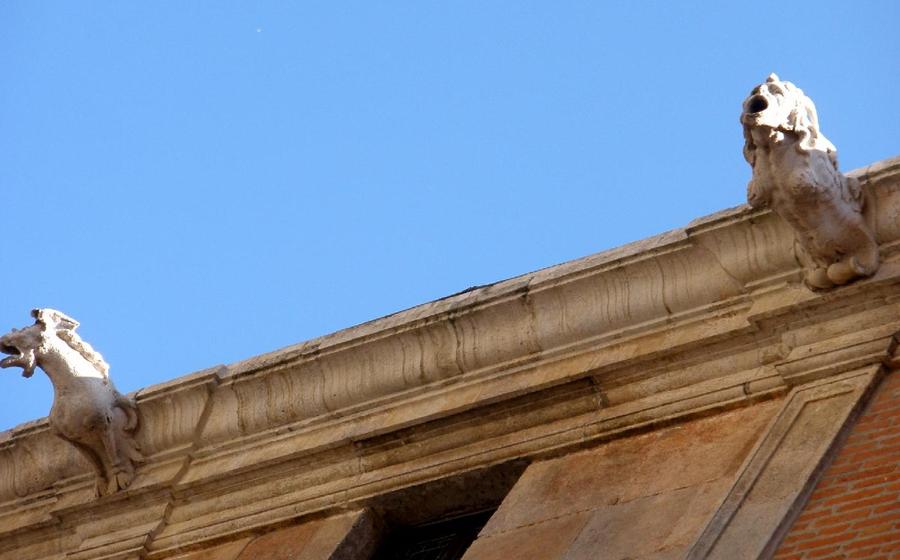
Museo de Burgos Casa Miranda
- Museo de Burgos: A Treasure Trove of History and Art
- Exploring the Museum's Collections:
- The Burgos Codex: A Masterpiece of Manuscript Illumination
- Casa Miranda: A Unique Architectural Gem
- Architectural Harmony
- Miranda's Touch
- A Unique Experience
- Interactive Exhibits and Multimedia Displays
- Guided Tours and Workshops
- Temporary Exhibitions and Events
- Accessibility and Facilities
- Photography and Videography Policy
- Admission Fees and Discounts:
- Souvenirs and Museum Shop
- Getting to the Museum
- Nearby Attractions and Points of Interest
- Historical Context and Significance
- Insider Tip:
Museo de Burgos: A Treasure Trove of History and Art
The Museo de Burgos is a captivating journey through the artistic and historical heritage of the city of Burgos and the surrounding region. Housed in a magnificent 16th-century palace, the museum boasts an extensive collection that spans from prehistoric times to the present day. With its rich and diverse exhibits, the Museo de Burgos offers a unique glimpse into the cultural and artistic legacy of this vibrant city.
The museum is strategically located in the heart of the historic center of Burgos, making it easily accessible for visitors. Its proximity to other cultural attractions, such as the iconic Burgos Cathedral, allows for a comprehensive exploration of the city's artistic and historical treasures.
A visit to the Museo de Burgos is a must for anyone interested in delving into the rich history and cultural heritage of Burgos. The museum's diverse collection, combined with its immersive exhibits and interactive displays, ensures an engaging and educational experience for visitors of all ages.
The ideal time to visit the Museo de Burgos is during the shoulder seasons (spring and autumn), when the weather is pleasant and the crowds are smaller. This allows for a more relaxed and enjoyable visit, with ample time to explore the museum's exhibits and appreciate its architectural beauty.
Exploring the Museum's Collections:
The Museo de Burgos houses a diverse and captivating collection that spans various periods of history, from prehistoric times to the contemporary era. Among the highlights are remarkable prehistoric artifacts, such as the Atapuerca Skull, which provides glimpses into the lives of early hominids in the region. The Roman and Visigothic periods are represented by fascinating mosaics, sculptures, and jewelry. The Middle Ages come alive through stunning Romanesque and Gothic artworks, including intricate carvings, polychrome sculptures, and illuminated manuscripts.
The museum's collection also boasts significant Renaissance and Baroque pieces, such as paintings by renowned artists like El Greco, Ribera, and Zurbarán. Visitors can admire the exquisite craftsmanship of gold and silver liturgical objects, as well as impressive tapestries and textiles. The 19th and 20th centuries are represented by works from local and national artists, showcasing the evolution of artistic styles and themes over time.
One of the most renowned artifacts in the museum is the Burgos Codex, a 10th-century manuscript that contains valuable information about the history and customs of the Kingdom of Castile. Its intricate illuminations and calligraphy have earned it recognition as a UNESCO World Heritage Site.
The museum's collection is meticulously organized into various sections, allowing visitors to delve into specific periods or themes. Each section features informative panels and labels that provide historical context and insights into the significance of the artifacts on display. Whether you're an art enthusiast, a history buff, or simply curious to learn more about Burgos's rich cultural heritage, the Museo de Burgos offers a treasure trove of discoveries waiting to be explored.
The Burgos Codex: A Masterpiece of Manuscript Illumination
The jewel in the crown of the Museo de Burgos's collection is undoubtedly the Burgos Codex, a magnificent illuminated manuscript dating back to the 10th century. This masterpiece of medieval artistry contains 196 folios of exquisitely crafted illustrations, intricate calligraphy, and vibrant colors, narrating the life and ministry of Jesus Christ.
The Burgos Codex is renowned for its exceptional artistic quality and its historical significance. It was commissioned by Count Fernán González, the first ruler of the independent County of Castile, and created by a team of talented scribes and illuminators. The codex bears witness to the cultural and artistic flourishing of the Kingdom of Castile during the 10th and 11th centuries.
To truly appreciate the beauty and significance of the Burgos Codex, it is essential to view it in person. The museum has taken great care to preserve and display this priceless artifact, showcasing it in a climate-controlled environment that protects its delicate parchment pages. Visitors can marvel at the intricate details of the illustrations, the vivid colors that have remained remarkably well-preserved over the centuries, and the elegant calligraphy that adorns the text.
To enhance your understanding of the Burgos Codex, the museum offers guided tours and informational panels that delve into its history, symbolism, and artistic techniques. You can also find a wealth of resources online, including digital reproductions of the codex and scholarly articles that explore its significance in the context of medieval art and history.
Casa Miranda: A Unique Architectural Gem
Casa Miranda, an architectural masterpiece situated within the Museo de Burgos, is a testament to the artistic prowess of its namesake, Ricardo Miranda. Constructed between 1929 and 1933, Casa Miranda was designed as a residence for the renowned artist, who played a pivotal role in the city's cultural scene. The building's design seamlessly blends diverse architectural styles, including Neo-Gothic, Art Deco, and Regionalist elements, reflecting Miranda's eclectic artistic influences.
Architectural Harmony
The facade of Casa Miranda captivates visitors with its intricate details and harmonious fusion of architectural styles. Neo-Gothic influences are evident in the pointed arches and elaborate stone carvings, while Art Deco elements manifest in the geometric shapes and bold lines. Regionalist motifs, inspired by traditional Spanish architecture, add a touch of local charm to the building's overall aesthetic.
Miranda's Touch
Ricardo Miranda's artistic vision is omnipresent throughout Casa Miranda. His signature style is evident in the decorative elements that adorn the building, including sculptures, stained glass windows, and intricate ironwork. Miranda's personal collection of artwork, which includes paintings, sculptures, and furniture, further enhances the building's artistic atmosphere.
A Unique Experience
Casa Miranda is not merely a residence; it is a testament to Miranda's creative genius and a symbol of Burgos's rich cultural heritage. Visitors to the Museo de Burgos can explore this architectural gem, immerse themselves in Miranda's artistic world, and gain a deeper appreciation for the city's vibrant cultural history.
Interactive Exhibits and Multimedia Displays
The Museo de Burgos offers a range of interactive exhibits and multimedia displays that enhance the visitor experience and bring the museum's collection to life. These exhibits utilize technology to engage visitors of all ages and provide a deeper understanding of the museum's artifacts and historical narratives.
One of the highlights of the interactive exhibits is a virtual reality experience that allows visitors to step into the world of the Burgos Codex. Through this immersive experience, visitors can explore the codex's pages, unravel its mysteries, and gain insights into the medieval world.
In addition, the museum features interactive touchscreens and multimedia displays that provide detailed information about the exhibits. Visitors can zoom in on artifacts, learn about their history and significance, and discover related stories and anecdotes. These interactive elements add a dynamic and engaging dimension to the museum experience.
To make the most of these interactive features, visitors are encouraged to take their time exploring the exhibits and utilizing the available resources. By engaging with the touchscreens, virtual reality experiences, and multimedia displays, visitors can gain a deeper appreciation for the museum's collection and the rich history of Burgos.
Guided Tours and Workshops
The Museo de Burgos offers a variety of guided tours that provide visitors with a deeper insight into the museum's collections and history. Tours are available in Spanish and English, and they cover a range of topics, including the museum's highlights, the Burgos Codex, and the history of Casa Miranda. The tours are led by experienced museum guides who are passionate about sharing their knowledge with visitors.
In addition to guided tours, the Museo de Burgos also offers educational workshops for children and families. These workshops are designed to engage children in the museum's collections through hands-on activities and interactive learning experiences. The workshops cover a variety of topics, such as medieval art, archaeology, and the history of Burgos.
To book a guided tour or workshop, visitors can contact the museum directly or reserve their spot online. It is recommended to book in advance, especially for groups or during peak tourist season. The guided tours and workshops are a great way to enhance your visit to the Museo de Burgos and learn more about the museum's collections and history.
Temporary Exhibitions and Events
The Museo de Burgos actively hosts temporary exhibitions and special events throughout the year, showcasing a diverse range of artistic and cultural expressions. These exhibitions often focus on specific themes, historical periods, or the work of renowned artists, both local and international.
Visitors can expect to encounter a variety of temporary exhibitions, including retrospectives, thematic displays, and contemporary art installations. These exhibitions provide an opportunity to delve deeper into specific aspects of art and history, while also showcasing the museum's commitment to promoting emerging and established talent.
To stay updated on upcoming exhibitions and events, visitors can check the museum's official website or social media channels. The museum regularly announces exhibition schedules, opening dates, and any special activities or programs associated with these events.
Participating in temporary exhibitions and events at the Museo de Burgos is a fantastic way to enhance your museum experience, gain new perspectives, and discover hidden gems in the world of art and culture.
Accessibility and Facilities
The Museo de Burgos is committed to ensuring that all visitors, regardless of their abilities, can enjoy and appreciate its collections. The museum is fully accessible, with wheelchair ramps, elevators, and accessible restrooms throughout the building. Visitors with disabilities can also borrow wheelchairs or request assistance from the museum staff.
In addition to accessibility features, the museum offers a range of amenities to enhance the visitor experience. These include a cloakroom where you can store your belongings, a cafeteria where you can grab a bite to eat or a drink, and a gift shop where you can purchase souvenirs and mementos of your visit.
For visitors with disabilities, the museum offers a variety of guided tours and programs that are specifically designed to meet their needs. These tours are led by experienced guides who are trained to provide information in a clear and accessible manner. The museum also offers educational workshops and programs for children with disabilities, which allow them to learn about history and art in a fun and engaging way.
Photography and Videography Policy
Photography and videography are allowed inside the Museo de Burgos, allowing visitors to capture their memories and share their experiences with others. However, certain guidelines and restrictions must be followed to ensure the preservation of the exhibits and the enjoyment of all visitors. Flash photography is strictly prohibited due to its potential to damage delicate artifacts and paintings. Furthermore, the use of tripods, selfie sticks, or any other equipment that may obstruct the flow of visitors is not permitted.
When capturing images, visitors are asked to be respectful of other guests and avoid disturbing their viewing experience. Additionally, photography and videography for commercial purposes are not allowed without prior permission from the museum authorities. By adhering to these guidelines, visitors can help maintain the integrity of the museum's collection while creating lasting memories of their visit.
Admission Fees and Discounts:
The Museo de Burgos offers a range of admission fees and discounts to cater to different visitors. General admission for adults is priced at a modest rate, providing access to the museum's permanent collections, temporary exhibitions, and interactive displays. Students, seniors, and families can take advantage of discounted rates, making the museum accessible to a wide audience. Additionally, the museum offers free admission on certain days of the week or during specific events. To ensure the best value, visitors are encouraged to check the museum's website or inquire at the ticket counter for current pricing and discount information.
Souvenirs and Museum Shop
The Museo de Burgos features a well-stocked gift shop where you can purchase a variety of souvenirs and mementos to commemorate your visit. The shop offers a diverse selection of items, including replicas of artifacts from the museum's collection, books on Burgos's history and culture, postcards, posters, and unique handicrafts.
One of the highlights of the museum shop is the collection of exclusive items inspired by the museum's exhibits. These one-of-a-kind souvenirs, such as jewelry, ceramics, and textiles, are designed to capture the essence of Burgos's rich heritage and are sure to be treasured by any art enthusiast.
Whether you're looking for a small token to remember your trip or a special gift for a loved one, the Museo de Burgos's gift shop has something for everyone. So be sure to stop by and browse the collection before you leave the museum.
Insider Tip:
-
Keep an eye out for limited-edition items and seasonal collections that are often available at the museum shop.
-
Consider purchasing a book or guidebook about Burgos's history and culture to enhance your understanding of the city and its heritage.
-
If you're traveling with children, the museum shop has a selection of educational toys and games that are both fun and educational.
Getting to the Museum
Reaching the Museo de Burgos is a breeze, whether you prefer public transportation or driving your own vehicle. For those relying on public transport, the museum is conveniently located near several bus stops, making it easily accessible from various parts of the city. If you're arriving by metro, the closest station is a short walk away, allowing you to seamlessly connect to the museum.
For those who prefer the convenience of driving, the museum offers ample parking options. A spacious parking lot is available right next to the museum, ensuring that you can safely and conveniently leave your car while you explore the museum's treasures.
The museum's proximity to the city center and other attractions is another advantage. Situated within easy walking distance of Burgos' historic heart, you can effortlessly combine your visit to the museum with other sightseeing adventures. Whether you want to explore the stunning Burgos Cathedral, stroll along the scenic Paseo del Espolón, or delve into the city's vibrant culinary scene, everything is just a stone's throw away.
Nearby Attractions and Points of Interest
The Museo de Burgos is strategically situated in the heart of the city's historic center, allowing visitors to seamlessly combine their visit with other cultural and historical attractions. Just a short walk away, you'll find the iconic Burgos Cathedral, a magnificent Gothic masterpiece that boasts awe-inspiring architecture and houses the remains of the legendary El Cid.
In close proximity to the museum, you can also explore the Paseo del Espolón, a beautiful tree-lined promenade that offers panoramic views of the Arlanzón River and the surrounding cityscape. Take a leisurely stroll along this picturesque path and soak in the vibrant atmosphere.
For those interested in delving deeper into Burgos's rich history, the Museo de la Evolución Humana (Museum of Human Evolution) is a must-visit. This fascinating museum showcases the remarkable story of human evolution through interactive exhibits and captivating displays.
To satisfy your culinary cravings, the surrounding area teems with a variety of restaurants and cafes catering to diverse tastes. Indulge in traditional Spanish cuisine, savor international flavors, or simply relax with a refreshing drink as you soak in the city's vibrant ambiance.
By planning an itinerary that encompasses the Museo de Burgos and these nearby attractions, you can create a memorable and fulfilling experience that immerses you in the cultural and historical tapestry of this captivating city.
Historical Context and Significance
The Museo de Burgos and Casa Miranda hold immense historical significance within the city of Burgos. The museum's collection offers a comprehensive journey through the region's rich past, from prehistoric times to the Middle Ages and beyond. Casa Miranda, on the other hand, stands as a testament to the city's architectural heritage, blending Gothic, Renaissance, and Plateresque styles in a harmonious masterpiece.
The museum's collection includes artifacts that shed light on Burgos's role as a strategic location along the Camino de Santiago, a major pilgrimage route. Visitors can admire medieval manuscripts, sculptures, and paintings that showcase the city's artistic and cultural prowess during that era. The Burgos Codex, a 10th-century illuminated manuscript, holds a particularly prominent place in the collection, renowned for its exquisite illustrations and historical value.
Over the years, the Museo de Burgos has evolved into a dynamic cultural institution, hosting temporary exhibitions, educational workshops, and public events that promote the understanding and appreciation of Burgos's heritage. It serves as a vital platform for preserving and celebrating the city's unique identity, while also fostering dialogue and cultural exchange.
Insider Tip:
-
Arrive early to beat the crowds: The Museo de Burgos is a popular destination, especially during peak tourist season. Aim to arrive early in the morning to avoid long lines and have a more peaceful experience.
-
Take advantage of the free guided tours: The museum offers free guided tours in Spanish and English at specific times throughout the day. These tours provide a deeper insight into the museum's collection and history.
-
Explore the museum at your own pace: If you prefer a more independent visit, take your time to wander through the galleries and explore the exhibits at your own leisure. The museum provides informative labels and panels that explain the significance of each artifact.
-
Don't miss the views from the rooftop terrace: Head to the museum's rooftop terrace for panoramic views of Burgos Cathedral and the surrounding cityscape. It's a great spot to relax, take in the scenery, and capture some memorable photos.
-
Try the tapas at Casa Miranda: After your visit to the museum, pop into the Casa Miranda restaurant located on the ground floor. It serves delicious tapas and traditional Spanish cuisine, making it a perfect place to refuel and soak in the atmosphere of this historic building.
